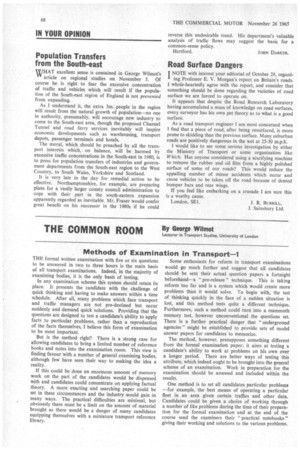Population Transfers from the South-east
Page 70

If you've noticed an error in this article please click here to report it so we can fix it.
WHAT excellent sense is contained in George Wilmot's article on regional studies on November 5. Of course he is right to fear the excessive concentration of traffic and vehicles which will result if the population of the South-east region of England is not prevented from expanding. As I understand it, the extra 3m. people in the region will result from the natural growth of population—no one in authority, presumably, will encourage new industry to come to the South-east area, though the proposed Channel Tunnel and road ferry services inevitably will inspire economic• developments such as warehousing, transport depots, passenger terminals and hotels. The moral, which should be preached by all the transport interests which, on balance, will be harmed by excessive traffic concentrations in the South-east in 1980, is to press for population transfers of industries and government departments from the South-east region to the West Country, to South Wales, Yorkshire and Scotland. It is very late in the day for remedial action to be effective. Northamptonshire, for example, are preparing plans for a vastly larger county council administration to cope with their part • in the south-eastern expansion apparently regarded as inevitable. Mr. Fraser would confer great benefit on his successor in the 1980s if he could
Road Surface Dangers
NOTE with interest your editorial of October 29, regard1 ing Professor E. V. Morgan's report on Britain's roads. I whole-heartedly agree with the report, and consider that something should be done regarding the varieties of road surface we are forced to operate on. It appears that despite the Road Research Laboratory having accumulated a mass of knowledge on road surfaces, every surveyor has his own pet theory as to what is a good surface. As a road transport engineer I am most concerned when I find that a piece of road, after being resurfaced, is more prone to skidding than the previous surface. Many suburban roads are positively dangerous in the wet at 25-30 m.p.h. would like to see some serious investigation by either the Ministry of Transport or some organization like Which. Has anyone considered using a scarifying machine to remove the rubber and oil film from a highly polished surface of some of our roads? This would reduce the appalling number of minor accidents which occur and cause vehicles to be taken off the road because of dented bumper bars and rear wings. If you feel like embarking on a crusade I am sure this is a worthy cause. London, SEI. J. R. BURRILL, J. Sainsbury Ltd.
















































































































